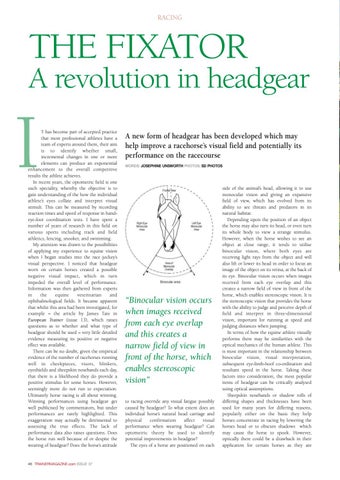FIXATOR ISSUE 37_Jerkins feature.qxd 04/03/2012 16:56 Page 1
RACING
THE FIXATOR
A revolution in headgear
I
T has become part of accepted practice that most professional athletes have a team of experts around them, their aim is to identify whether small, incremental changes in one or more elements can produce an exponential enhancement to the overall competitive results the athlete achieves. In recent years, the optometric field is one such speciality, whereby the objective is to gain understanding of the how the individual athlete’s eyes collate and interpret visual stimuli. This can be measured by recording reaction times and speed of response in handeye-foot coordination tests. I have spent a number of years of research in this field on various sports including track and field athletics, fencing, snooker, and swimming. My attention was drawn to the possibilities of applying my experience to equine vision when I began studies into the race jockey’s visual perspective. I noticed that headgear worn on certain horses created a possible negative visual impact, which in turn impeded the overall level of performance. Information was then gathered from experts in the equine veterinarian and ophthalmological fields. It became apparent that whilst this area had been investigated, for example – the article by James Tate in European Trainer (issue 13), which raises questions as to whether and what type of headgear should be used – very little detailed evidence measuring its positive or negative effect was available. There can be no doubt, given the empirical evidence of the number of racehorses running well in cheekpieces, visors, blinkers, eyeshields and sheepskin nosebands each day, that there is a likelihood they do provide a positive stimulus for some horses. However, seemingly more do not run to expectation. Ultimately horse racing is all about winning. Winning performances using headgear get well publicised by commentators, but under performances are rarely highlighted. This exaggeration may actually be detrimental to assessing the true effects. The lack of performance data also raises questions. Does the horse run well because of or despite the wearing of headgear? Does the horse’s attitude
46 TRAINERMAGAZINE.com ISSUE 37
A new form of headgear has been developed which may help improve a racehorse’s visual field and potentially its performance on the racecourse WORDS: JOSEPHINE UNSWORTH PHOTOS: SD PHOTOS
“Binocular vision occurs when images received from each eye overlap and this creates a narrow field of view in front of the horse, which enables stereoscopic vision” to racing override any visual fatigue possibly caused by headgear? To what extent does an individual horse’s natural head carriage and physical confirmation affect visual performance when wearing headgear? Can optometric theory be used to identify potential improvements in headgear? The eyes of a horse are positioned on each
side of the animal’s head, allowing it to use monocular vision and giving an expansive field of view, which has evolved from its ability to see threats and predators in its natural habitat. Depending upon the position of an object the horse may also turn its head, or even turn its whole body to view a strange stimulus. However, when the horse wishes to see an object at close range, it tends to utilise binocular vision, where both eyes are receiving light rays from the object and will also lift or lower its head in order to focus an image of the object on its retina, at the back of its eye. Binocular vision occurs when images received from each eye overlap and this creates a narrow field of view in front of the horse, which enables stereoscopic vision. It is the stereoscopic vision that provides the horse with the ability to judge and perceive depth of field and interpret in three-dimensional vision, important for running at speed and judging distances when jumping. In terms of how the equine athlete visually performs there may be similarities with the optical mechanics of the human athlete. This is most important in the relationship between binocular vision, visual interpretation, subsequent eye-limb-hoof co-ordination and resultant speed in the horse. Taking these factors into consideration, the most popular items of headgear can be critically analysed using optical assumptions. Sheepskin nosebands or shadow rolls of differing shapes and thicknesses have been used for many years for differing reasons, popularly either on the basis they help horses concentrate in racing by lowering the horses head or to obscure shadows which may cause the horse to spook. However, optically there could be a drawback in their application for certain horses as they are
